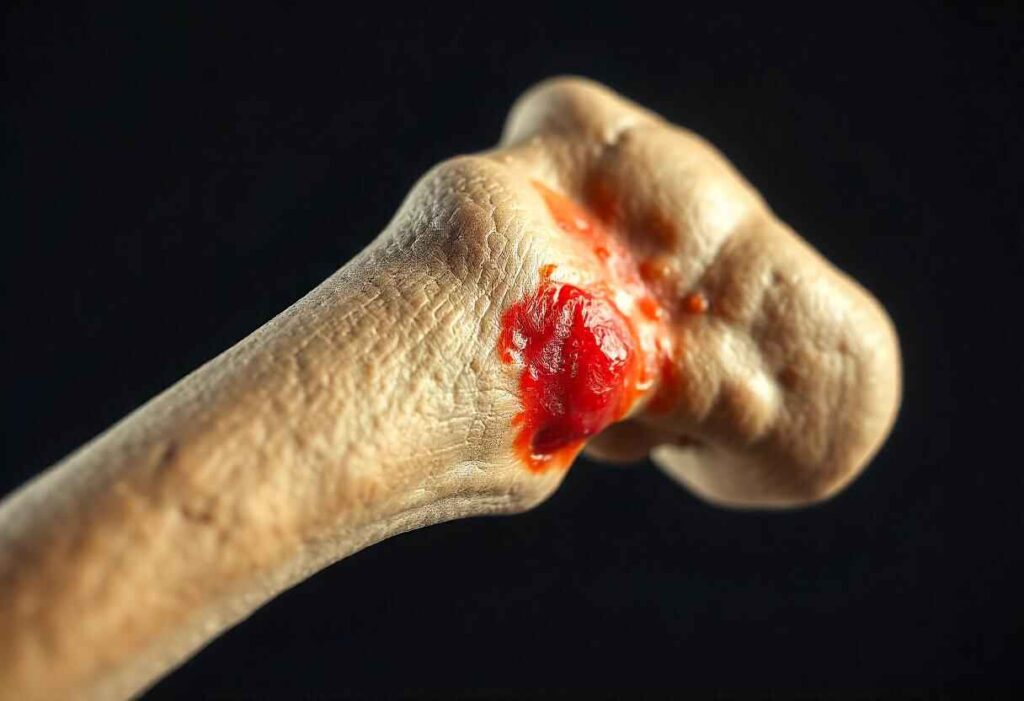Osteomyelitis is a condition where the bone gets infected. This happens when bacteria or fungi enter the bone, usually through the bloodstream, an infection in nearby tissue, or an open wound. Osteomyelitis can lead to severe issues like bone loss, persistent infection, and in certain situations, surgery, if left untreated.
What is Osteomyelitis?
A bacterial infection is typically the cause of osteomyelitis, a swelling of the bone. Staphylococcus aureus, commonly referred to as a staph infection, is the most frequent bacterium that causes it. However, this illness can occasionally be caused by different kinds of bacteria or even fungi.
Although this illness can damage any bone, it usually affects the long bones in the arms or legs in children and the spine or hips in adults. Osteomyelitis can develop gradually over time (chronic) or rapidly (acute). How quickly the infection is identified and treated determines how serious it is.
Common Symptoms of Osteomyelitis
The kind of infection, where it occurs, and the age of the patient can all affect osteomyelitis symptoms. Typical indicators include:
- Bone Pain: When moving or exerting pressure, the infected bone may become excruciatingly painful.
- Redness and Swelling: The region surrounding the infection may turn red, warm, and swollen.
- Fever and chills: Since it is an infection, the body frequently reacts by experiencing both of these symptoms.
- Fatigue: People who have osteomyelitis may feel exhausted and generally ill.
- Pus Drainage: If an infection penetrates the skin, it may occasionally cause pus to flow away from the infection site.
Causes of Osteomyelitis
Germs that enter the body and go to the bone are a common cause of osteomyelitis. This occurs most frequently in the following ways:
- Infection of the Bloodstream: Bacteria or fungi that are present in the blood might spread to the bones. It’s known as “haematogenous osteomyelitis” and is more prevalent in kids.
- Infection Close by: Infections from adjacent tissues, such the muscles or skin, can occasionally travel to the bones. Usually, this happens to adults, especially those who have long-term medical issues like diabetes.
- Open Wounds or Surgery: Bone-exposing injuries, such fractures, or bone-related surgeries can give germs a direct route into the body and lead to infection.
How is Osteomyelitis Diagnosed?
A doctor will run a number of tests to confirm the diagnosis if they suspect osteomyelitis. These could consist of:
- Blood tests: These can assist in detecting indicators of inflammation or an increased white blood cell count, which are indicators of infection.
- Imaging Tests: Changes in bone structure that indicate infection can be seen on X-rays, MRIs, or CT scans.
- Bone Biopsy: To pinpoint the precise bacteria or fungi causing the infection, a little sample of bone tissue may be collected and examined in a laboratory.
Treatment Options for Osteomyelitis
Usually, a combination of antibiotics and, occasionally, surgery is used to treat osteomyelitis. The objective is to eradicate the infection and stop more bone deterioration.
- Antibiotics: In order to combat the illness, doctors typically recommend a course of oral or intravenous antibiotics. The bacteria causing the infection determines the kind of antibiotic to use. To make sure the infection is totally eradicated, patients may need to take antibiotics for a few weeks.
- Surgery: Surgery can be necessary if the infection is severe or has seriously damaged the bone. Surgeons can drain abscesses, remove dead or infected bone tissue, and, in the worst situations, rebuild the bone with reconstructive surgery.
- Hyperbaric Oxygen Therapy (HBOT): Hyperbaric oxygen treatment may be used in certain situations. By raising the blood’s oxygen content, this medication can aid the body’s defense against the illness and hasten its healing process.
Understanding ICD-10 Codes for Osteomyelitis
In the medical world, the ICD-10 (International Classification of Diseases, 10th Revision) system is used to classify and code diseases for record-keeping, billing, and insurance purposes. Osteomyelitis is categorized under several ICD-10 codes based on the type and location of the infection.
Here are some of the most commonly used ICD-10 codes for osteomyelitis:
- M86.0: Acute hematogenous osteomyelitis – Acute (sudden) bone infections are brought on by germs that enter the bloodstream and infect the bone.
- M86.1: Chronic osteomyelitis with draining sinus – Refers to long-term bone infections that have caused an abnormal channel, or sinus, to develop through which pus can drain.
- M86.2: Subacute osteomyelitis – Refers to a less severe but still persistent infection of the bone.
- M86.3: Chronic multifocal osteomyelitis – Involves persistent infection in several bone sites.
- M86.4: Osteomyelitis associated with prosthetic devices – This refers to bone infections that develop around artificial devices like joint replacements.
- M86.8: Other osteomyelitis – This code is used for any other specific forms of osteomyelitis not mentioned in the previous categories.
Each of these codes helps healthcare providers track the condition’s type, severity, and treatment progress.
Conclusion
Osteomyelitis is a serious bone infection that needs quick medical attention. If you notice signs like intense pain, swelling, or a fever, it’s important to visit a doctor right away. Early diagnosis and treatment can stop complications and help you recover fully.
Knowing the ICD-10 codes for osteomyelitis can also be helpful for patients and caregivers. These codes help with understanding medical records, insurance, and treatment plans. With the right care, osteomyelitis can be treated successfully, allowing most people to regain normal bone health and function.

